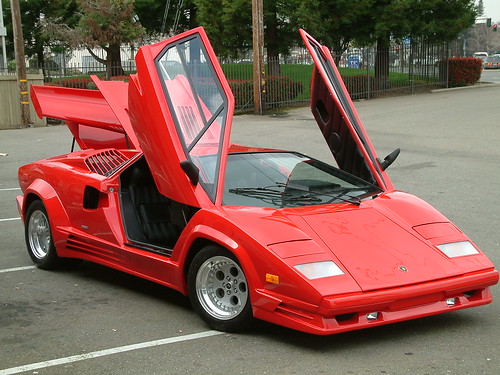Lamborghini Countach was a mid-engined sports car produced by Italian automaker Lamborghini from 1974 to 1990. Its design both pioneered and popularized the wedge-shaped, sharply angled look popular in many high performance sports cars. The “cabin-forward” design concept, which pushes the passenger compartment forward in order to accommodate a larger engine, was also popularized by the Countach.
In 2004, American car magazine Sports Car International named this car number three on the list of Top Sports Cars of the 1970s, and it was listed as number ten on their list of Top Sports Cars of the 1980s.

Great Lamborghini Countach picture
 Lamborghini Countach
Lamborghini CountachGreat Lamborghini Countach
The Countach was styled by Marcello Gandini of the Bertone design studio, the same designer and studio that designed the Miura. Gandini was then a young, inexperienced designer—not very experienced in the practical, ergonomic aspects of automobile design, but at the same time unhindered by them. He produced a quite striking design. The Countach shape was wide and low (42.1 inches), but not very long. Its angular and wedge-shaped body was made almost entirely of flat, trapezoidal panels. There were curves, notably the smoothly coke-bottle wing line, but the overall appearance was sharp.
The doors, a Countach trademark, were scissor doors: hinged at the front with horizontal hinges, so that the doors lifted up and tilted forwards. The main reason is the car’s tubular spaceframe chassis results in very high and wide door sills. It was also partly for style, and partly because the width of the car made conventional doors impossible to use in an even slightly confined space. Care needed to be taken, though, in opening the doors with a low roof overhead. The car’s poor rear visibility and wide sills led to drivers adopting a method of reversing the car for parking by opening the door, sitting on the sill, and reversing while looking over the back of the car from outside.)
The pure style of the prototype was progressively enhanced or cluttered (depending on one’s point of view) by the evolution of the car to improve its performance, handling, tractability, and ability to meet mandated requirements. This began with the first production model, which included several vents which were found to be necessary to cool the engine adequately. These included the iconic NACA duct on the door and rear fender of each side of the car. The car design changes ended with a large engine vent directly behind the driver, reducing the rear view. Later additions, including fender flares, spoilers, carburetor covers, and bumpers, progressively changed the aesthetic values of the car.
The Countach’s styling and visual impression caused it to become an icon of great design to almost everyone except automotive engineers. The superior performance characteristics of later Lamborghini models (such as the Diablo, or the Murciélago) appealed to performance car drivers and engineers, but they never had the originality or outrageousness that gave the Countach its distinction. The different impressions left by the various Lamborghini models have generated numerous debates and disagreements over what constitutes ‘classic’ or ‘great’ automotive design (elegant looks and style, vs. technical and engineering superiority).

No comments:
Post a Comment